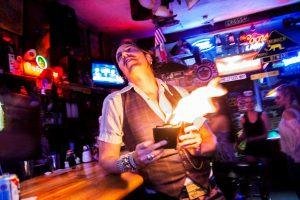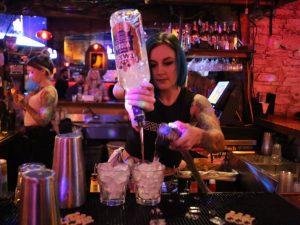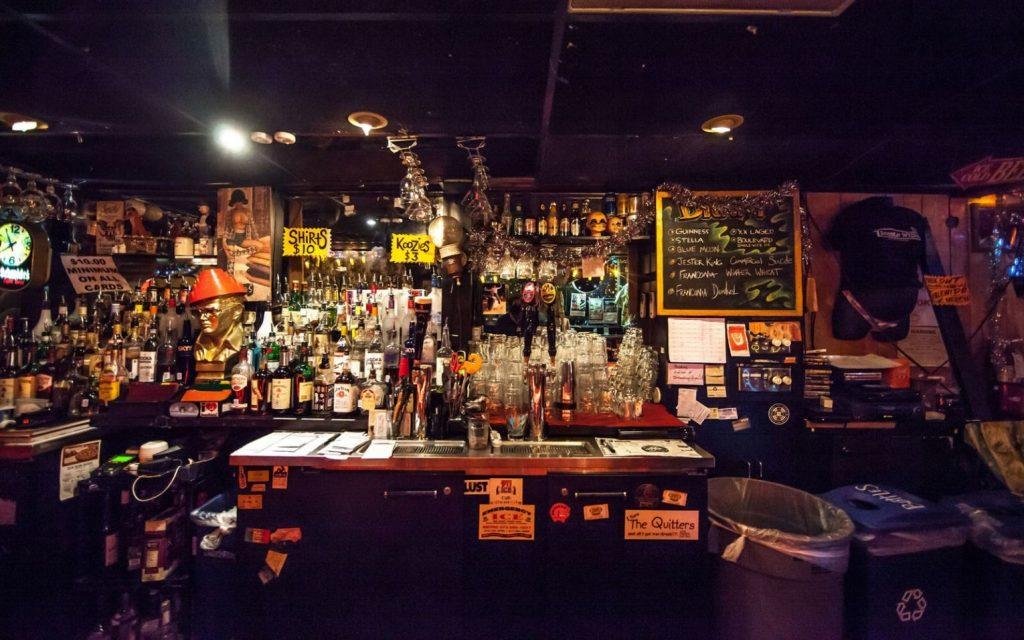American Original: The Dive Bar
 There’s nothing like a dingy neighborhood dive with cheap drinks, fun games, and no pretenses. They’re few and far between these days, but they’re out there and worth the search. While it’s hard to define what makes a dive a dive, you know it when you see one—it feels like home. Perhaps a well lived-in home, but home nonetheless. A real dive bar wouldn’t call itself a dive, so if it’s in the name, you know damn well that it’s a sanitized re-imagining of what a dive bar is and most likely filled with hipsters drinking micro-brews over an ‘artisanal’ cheese board that has undoubtedly been given some sort of low-brow name on the menu.
There’s nothing like a dingy neighborhood dive with cheap drinks, fun games, and no pretenses. They’re few and far between these days, but they’re out there and worth the search. While it’s hard to define what makes a dive a dive, you know it when you see one—it feels like home. Perhaps a well lived-in home, but home nonetheless. A real dive bar wouldn’t call itself a dive, so if it’s in the name, you know damn well that it’s a sanitized re-imagining of what a dive bar is and most likely filled with hipsters drinking micro-brews over an ‘artisanal’ cheese board that has undoubtedly been given some sort of low-brow name on the menu.
 No, real dive bars aren’t made, they just happen. If a ‘new’ dive bar pops up and has distressed finishes and well-worn accouterments like some chain restaurant, run the other way. The wear and tear wasn’t earned the way it would be in an actual dive. Distressing in an actual dive bar comes from putting cigarettes out, spilling beer, or repeatedly being bumped with a pool cue. A real dive bar is a place where you’ll wanna sidle up to the bar, order a cheap whiskey or beer served in cans, and get a greasy basket of tots and every dent and ding has a story to tell. These are the places where the jukeboxes are always playing, Christmas lights hang year-round, and you’re bound to leave with a couple of new friends and some stories of your own.
No, real dive bars aren’t made, they just happen. If a ‘new’ dive bar pops up and has distressed finishes and well-worn accouterments like some chain restaurant, run the other way. The wear and tear wasn’t earned the way it would be in an actual dive. Distressing in an actual dive bar comes from putting cigarettes out, spilling beer, or repeatedly being bumped with a pool cue. A real dive bar is a place where you’ll wanna sidle up to the bar, order a cheap whiskey or beer served in cans, and get a greasy basket of tots and every dent and ding has a story to tell. These are the places where the jukeboxes are always playing, Christmas lights hang year-round, and you’re bound to leave with a couple of new friends and some stories of your own.
 Dives don’t generally make an effort to appeal to cleanliness. It’s not that they’re dirty or unsanitary, they’re just not as clean as You can love a dive bar, even think of it as home, but still be disgusted by it—and maybe that’s why you love it in the first place? The flip side of that attraction to dive bars is that we sometimes fetishize them. It’s not just working-class people who seek out dives, it’s everyone who wants to burrow into someplace dark and beery for a few hours and there’s nothing wrong with that. Not everyone’s ‘third place’ is a coffee shop. Hell, imagine how much better Friends might have been if they didn’t hang out in Central Perk all the time? Would it have killed anyone to hit up a nice NYC dive bar every few episodes …?
Dives don’t generally make an effort to appeal to cleanliness. It’s not that they’re dirty or unsanitary, they’re just not as clean as You can love a dive bar, even think of it as home, but still be disgusted by it—and maybe that’s why you love it in the first place? The flip side of that attraction to dive bars is that we sometimes fetishize them. It’s not just working-class people who seek out dives, it’s everyone who wants to burrow into someplace dark and beery for a few hours and there’s nothing wrong with that. Not everyone’s ‘third place’ is a coffee shop. Hell, imagine how much better Friends might have been if they didn’t hang out in Central Perk all the time? Would it have killed anyone to hit up a nice NYC dive bar every few episodes …?
Ok, so maybe we’re rambling about our love of dive bars, but can you blame us? Crack open a tallboy and check out a few of our favorites, including a few that may have checked out a long time ago, but still hold a place in that dark, dingy corner in our hearts. And if you’ve never experienced a real dive bar, just do it. Try something new. Live dangerously. Who knows, you might find your place?
Below are ten of our favorite dive bars of all time and while sadly, you can no longer experience them, you can however get the t-shirt and tell people you did or just look cool in a truly unique vintage-style piece.
XXX

Red Rock West Saloon, New York City 1996
New York’s Red Rock West could have been Coyote Ugly’s truly ugly, possibly inbred cousin. With an obvious cowboy roadhouse type vibe accented with the stench of stale beer and a Harley riding (or wannabe riding) clientele and tables with no chairs, Red Rock West Saloon was not your typical NYC nightspot to say the least. However, any shortcomings were quickly overlooked as the bartenders were hot and very much known for putting on an engaging show with plenty of audience interaction, again, think Coyote Ugly.
XXX
Nitelite Lounge, Seattle 1939
This old school dive bar on the border in Seattle’s Belltown neighborhood first opened it’s doors in 1939. They served up cheap (and stiff!) drinks from nice, but no-nonsense bartenders in a colorful, no-fuss, vintage atmosphere. It was the kind of place where bike messengers, old-timers, metal heads, hipsters, and oddball downtown characters sat side-by-side in harmony. They also had live music, dart boards, pool tables, a killer happy hour, and strangely, really good food. It closed suddenly in Spring 2016 and locals have lamented the loss of “the last real bar in Seattle” ever since.
XXX

Hop Louie, Los Angeles 1985
At first glance, the traditional Chinese pagoda facade didn’t speak much to revelry, but once inside, namely in the downstairs bar, it was a totally different story. At Hop Louie, the Chinese lanterns and a lacquered bar top gave way to the old school charm of the oldies-playing jukebox, low lights, and cheap, stiff drinks. You knew that you were without question in a great dive bar, but this one just happened to serve some of the best Chinese food in Los Angeles. The restaurant opened as Golden Pagoda (the name changed in 1985) a couple of years after “New Chinatown” was built in 1938.
XXX
Die Kobra Shisha Verein, Worlfsburg 1997
Die Kobra Shisha Verein (The Cobra Shisha Club) was a popular German hookah lounge in the city of Worlfsburg which opened it’s doors in the summer of 1997. Aside from the traditional shared shisha (flavored tobacco) from communal hookahs, Die Kobra maintained a comprehensive small plate menu and full bar where they prepared true hand-crafted cocktails using only premium ingredients.
XXX

The Toy Tiger, Louisville 1973
The Toy Tiger of Louisville, Kentucky was home to all kinds of debauchery that involved scantily clad young women in some capacity. Ranging from wet t-shirt and sexy banana eating contests, this joint made no apologies for being sleazy and never pretended to be something it wasn’t and when the stage wasn’t being used to debase women, it played host to an amazing array of national touring bands as well as popular local acts. It’s iconic, animated Las Vegas style marquee stood on Bardstown Road from the time it opened it’s doors in 1973 until last call in 1999 and then it hung around for some time after that as the building sat empty, falling into disrepair and then being razed to make way for a gas station.
see the shirt »
XXX
Colorado Mine Company, Denver 1971
Denver’s Colorado Mine Company was one of those places that wasn’t what it seemed. It was a dive bar of sorts, but slightly classier and wrapped in a unique style of western kitsch with a menu to match. It was the kind of place your mother had warned you about, but that only made it that much more fun to hang out there. The restaurant lives on in America’s collective consciousness as the creator of the “Fool’s Gold” sandwich, one of Elvis Presley’s all-time favorites, so much so that he would fly his private jet from Graceland to Denver just to get his fix.
see the shirt »

XXX

The Continental Bar, New York City 1991
The Continental Bar in Manhattan’s East Village first opened as a live music bar way back in 1991 and played host to NYC punk rockers like The Ramones and Iggy Pop, but in 2006 the stage was replaced with leather booths which started a clear path to living out its remaining days as a dive bar. As a venue, it was known for hosting lots of punk and rock shows, and as a dive, it was known for its loud signs out front that advertised cheap shots and a happy hour that lasts until late night. The single biggest draw was probably the “5 shots of anything for $10 deal” which ran counter to the owner’s attempts at making it a “classy dive bar.” Nonetheless, location goes a long way in business and despite all kinds of bad press and equally bad reviews, it was packed almost every night until it’s final demise at the end of 2018.
XXX
Outlaw Saloon, Afton 1989
Afton is a town in Lincoln County, Wyoming with a population just under 2,000 as of the 2010 census. Afton is home to the world’s largest arch made of elk antlers, a true work of art spanning 75 feet across the four lanes of US Highway 89, the arch consists of 3,011 elk antlers and weighs over 15 tons. Roadside oddities aside, Afton is also home to the storied Outlaw Saloon, a watering hole that attracts locals, road tripping bikers, and truckers alike. So whether you are into smoking and drinking or fighting and f*cking, the Outlaw Saloon may be just the place for you! This two sided design includes both front and back prints!
see the shirt »

XXX

The Melody Room, Los Angeles 1951
From 1951 to 1969 the building now known as The Viper Room served as a cabaret, call The Melody Room, run by brothers Pete and Billy Snyder. For 18 years, the Melody Room was known almost as well for its diverse lineup of performers as it was the eclectic mix of Hollywood celebrities and mobsters who made the place their hang out. While this joint didn’t start out as a dive bar, as cabaret fell out of favor, The Melody Room started it’s slow transition into a low-key drinking spot, aka a dive bar.
see the shirt »
XXX
Boar’s Nest, Hazzard County 1979
Yeah, we know, it’s not a real place and maybe not quite a dive bar, but the line between roadhouse and dive bar is easily blurred and as Dukes of Hazzard fans, we going with it! The Boar’s Nest is a fictional business from the film Moonrunners, and the The Dukes of Hazzard TV series and films. The fictional Boar’s Nest is based on the real Boar’s Nest bar from the area where Jerry Rushing used to run moonshine. His stories were the basis for both Moonrunners and The Dukes of Hazzard. It is a bar—that also sells gas, and serves food—owned by Boss Rainey/Hogg where the people of Shiloh/Hazzard County meet and socialize.
Of course, we’re more than just dive bar shirts, so pop by and check out all the cool designs we have in the shop!



El Sol Bar 1966 Vintage Men’s T-Shirt
Wyld Stallyns 2020 Vintage Men’s T-Shirt
Pterodactyl Club 1987 Vintage Men’s T-Shirt